
Jan Kott was a Polish political activist, critic and theoretician of the theatre. A leading proponent of Stalinism in Poland for nearly a decade after the Soviet takeover, Kott renounced his Communist Party membership in 1957 following the anti-Stalinist Polish October of 1956. He defected to the United States in 1965. He is regarded as having considerable influence upon Western productions of Shakespeare in the second half of the 20th century.

Ascidia is a genus of tunicates in the family Ascidiidae.

Pyura is a large genus of sessile ascidians that live in coastal waters at depths of up to 80 m (260 feet). Like all ascidians, Pyura are filter feeders. A few species, including Pyura chilensis are commercially fished.

Didemnum is a genus of colonial tunicates in the family Didemnidae. It is the most speciose genus in the didemnid family. Species in this genus often have small calcareous spicules embedded in the tunic and form irregular or lobed colonies. Some Didemnum species, including Didemnum vexillum and Didemnum perlucidem are considered invasive species. In early 2006, Didemnum vexillum was found covering a 230 km2 area of cobble habitat in Georges Bank off the coast of New England, and is classified as an invasive species of greatest concern in coastal areas throughout Europe, New Zealand, and North America. Didemnum sp. invasions have also been recorded in Canada, the Mediterranean, and the Netherlands.
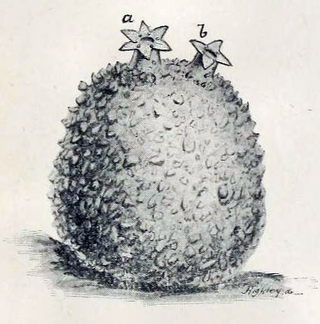
Molgula, or sea grapes, are very common, globular, individual marine tunicates roughly the size of grapes.

Phlebobranchia is an order of sea squirts in the class Ascidiacea, first described by Fernando Lahille in 1886.

Stolidobranchia is an order of tunicates in the class Ascidiacea. The group includes both colonial and solitary animals. They are distinguished from other tunicates by the presence of folded pharyngeal baskets. This provides the etymology of their name: in ancient Greek, στολίς, ίδος means the "fold" of a cloth. Stolidobranchian sea squirts are also characterized by the complete absence of an abdomen. The abdominal organs of other tunicates are instead located to one side of the pharyngeal basket in this group.
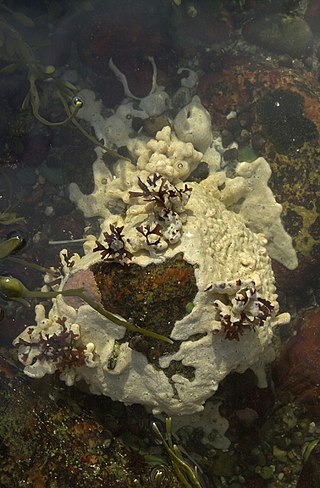
Aplousobranchia is an order of sea squirts in the class Ascidiacea, first described by Fernando Lahille in 1886. They are colonial animals, and are distinguished from other sea squirts by the presence of relatively simple pharyngeal baskets. This provides the etymology of their name: in ancient greek, ἁ.πλοος-ους (ha.ploos-ous) means "simple". The posterior part of the abdomen contains the heart and gonads, and is typically larger than in other sea squirts.

Aplidium is a genus of colonial sea squirts, tunicates in the family Polyclinidae. There are about 188 species in the genus found in shallow waters around the world.

Aplidium californicum is a species of colonial sea squirt, a tunicate in the family Polyclinidae. It is commonly known as sea pork.
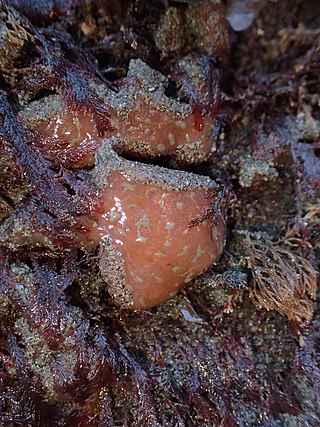
Aplidium solidum is a species of colonial sea squirts, a tunicate in the family Polyclinidae. It is commonly known as the red ascidian or sea pork.
Entosphenus is a genus of lampreys.
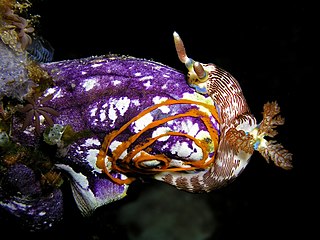
Polycarpa is a genus of ascidian tunicates in the family Styelidae.
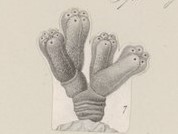
Synoicum is a genus of colonial sea squirts, tunicates in the family Polyclinidae.

Aplidium elegans, the sea-strawberry, is a species of colonial sea squirt, a tunicate that is a benthic invertebrate in the family Polyclinidae and class Ascidiacea. It is native to shallow waters in the Atlantic Ocean and Mediterranean Sea. It is also found in between France and the United Kingdom.

Sylvia Kotting-Uhl is a German politician of Alliance 90/The Greens who served as a member of the Bundestag from the state of Baden-Württemberg from 2005 until 2021.
Adagnesia antarctica is a species of tunicate in the family Agneziidae, first described by Patricia Kott in 1969.
Aplidium abditum is a sea squirt in the family Polyclinidae and was first described in 2006 by Patricia Kott, from a specimen collected at 6-8 m depth at Port Davey, Tasmania.
Aplidium formosum is a sea squirt in the family Polyclinidae and was first described in 2006 by Patricia Kott, from a specimen collected at 3 m depth in Port Adelaide, South Australia.












